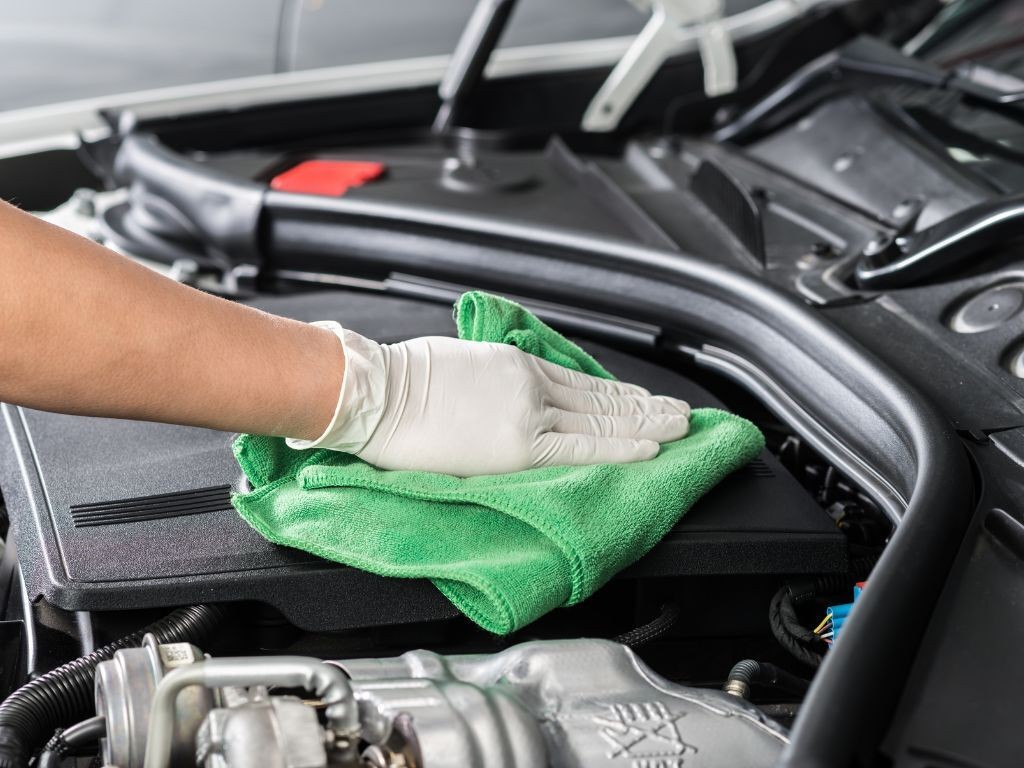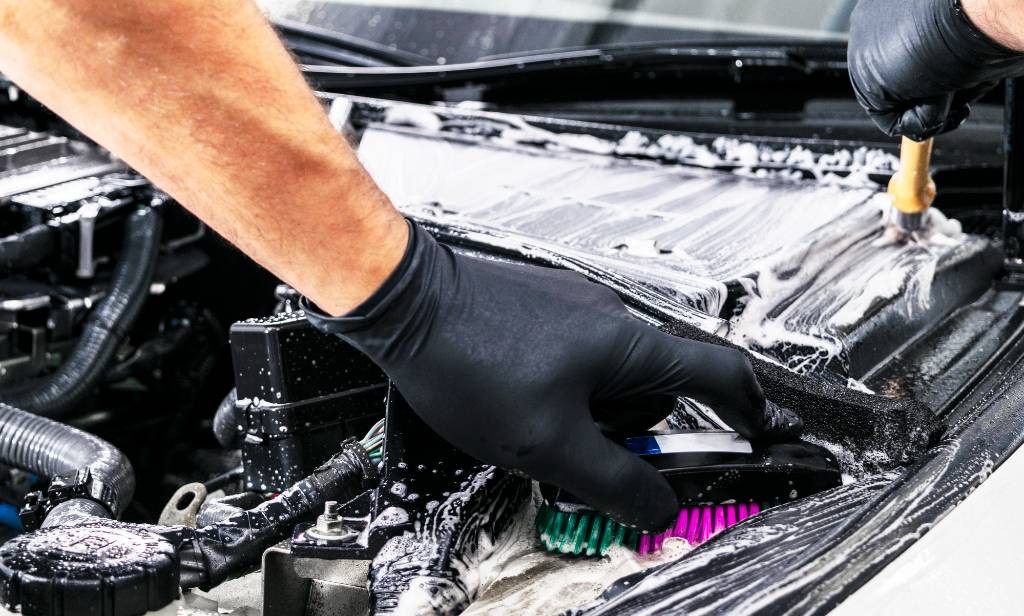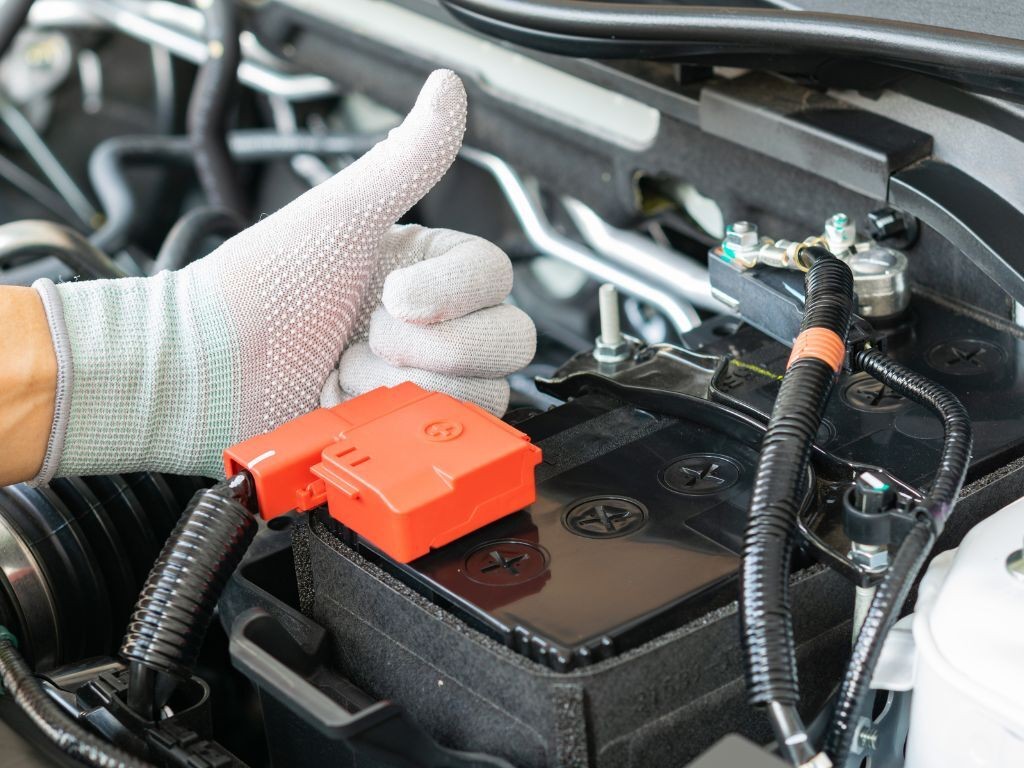Cleaning the motor of your car enhances its appearance and prolongs the life of vital components. CARS.EDU.VN provides a comprehensive guide to help you achieve a spotless and well-maintained engine bay. Learn expert techniques and essential tips to keep your engine running smoothly with our detailed advice on car care and motor maintenance.
1. Why Cleaning Your Car’s Motor Matters
Keeping your car’s motor clean isn’t just about aesthetics; it’s crucial for its overall health and performance. A clean engine bay allows for better heat dissipation, preventing overheating and potential damage to components. According to a study by the Society of Automotive Engineers (SAE), a clean engine runs up to 10% cooler than a dirty one. This can significantly extend the lifespan of hoses, belts, and other parts susceptible to heat damage.
Furthermore, a clean engine makes it easier to spot leaks and other potential problems. Regular cleaning allows you to identify issues early, preventing costly repairs down the line. For example, oil leaks are much more visible on a clean engine, enabling you to address them before they cause significant damage.
Here’s why cleaning your engine bay regularly matters:
- Improved cooling: Prevents overheating.
- Easier leak detection: Helps identify potential problems early.
- Extended component life: Protects hoses, belts, and other parts.
- Enhanced aesthetics: Makes your car look well-maintained.
- Increased resale value: A clean engine bay can increase your car’s appeal to potential buyers.
CARS.EDU.VN offers in-depth articles and guides on engine maintenance, helping you understand the importance of regular cleaning and how it contributes to your car’s longevity. For example, you can find detailed instructions on identifying and addressing common engine problems, ensuring your vehicle remains in top condition.
2. Essential Tools and Supplies for Motor Cleaning
Before you begin cleaning your car’s motor, gather all the necessary tools and supplies to ensure a smooth and effective process. Having the right equipment not only makes the job easier but also helps prevent damage to sensitive engine components.
Here’s a list of essential tools and supplies:
- Protective Gear: Gloves, safety glasses, and a mask.
- Cleaning Solutions: Engine degreaser, all-purpose cleaner, and car wash soap.
- Brushes: Detailing brushes of various sizes, a soft-bristled brush, and a toothbrush for tight spots.
- Spray Bottles: For applying cleaning solutions.
- Water Source: Garden hose with adjustable nozzle or a pressure washer (use with caution).
- Microfiber Towels: For drying and wiping surfaces.
- Plastic Bags or Covers: To protect sensitive electrical components.
- Vacuum Cleaner or Blower: For removing loose debris.
- Optional: Steamer for deep cleaning.
Ensure you choose high-quality products specifically designed for automotive use. Using household cleaners can damage plastic and rubber components in the engine bay. According to experts at CARS.EDU.VN, investing in professional-grade cleaning solutions can significantly improve the results and protect your car’s engine.
3. Step-by-Step Guide: How to Safely Clean Your Car’s Motor
Cleaning your car’s motor can seem daunting, but following a step-by-step guide ensures a safe and effective process. This section provides a detailed walkthrough, incorporating expert tips and precautions.
3.1. Preparation is Key: Cooling Down and Disconnecting the Battery
- Cool Down: Allow your engine to cool completely before starting. Working on a hot engine can cause burns and damage components. It typically takes 2-3 hours for an engine to cool down properly.
- Disconnect the Battery: Disconnect the negative terminal of the battery to prevent electrical shorts. Use a wrench to loosen the nut on the negative terminal, remove the cable, and secure it away from the battery post.
3.2. Protecting Sensitive Components: Covering Electrical Parts
- Identify Sensitive Areas: Locate components like the alternator, distributor, fuse box, and any exposed wiring.
- Cover with Plastic: Use plastic bags or covers to protect these areas from water and cleaning solutions. Secure the covers with tape to prevent them from shifting during the cleaning process.
3.3. Removing Loose Debris: Vacuuming and Brushing
- Vacuum First: Use a vacuum cleaner with a hose attachment to remove loose leaves, dirt, and debris. Pay attention to corners and hard-to-reach areas.
- Brush Away Stubborn Dirt: Use a soft-bristled brush to loosen any remaining dirt. Be gentle to avoid damaging any components.
3.4. Applying Degreaser: Breaking Down Grease and Grime
- Choose the Right Degreaser: Select an engine degreaser specifically designed for automotive use. Avoid using harsh chemicals that can damage plastic and rubber parts.
- Apply Evenly: Spray the degreaser evenly over the engine bay, focusing on areas with heavy grease and grime buildup. Follow the manufacturer’s instructions for dwell time, typically 5-10 minutes.
3.5. Scrubbing and Agitating: Getting into Tight Spots
- Use Detailing Brushes: Use detailing brushes of various sizes to scrub away grease and grime. A toothbrush can be helpful for cleaning tight spots.
- Agitate Gently: Avoid applying too much pressure, as this can damage sensitive components. Focus on gently agitating the dirt and grease to loosen it.
3.6. Rinsing: Removing Degreaser and Dirt
- Use a Gentle Water Stream: Rinse the engine bay with a garden hose using a gentle spray nozzle. Avoid using a high-pressure stream, as this can force water into sensitive areas.
- Rinse Thoroughly: Ensure all degreaser and dirt are completely removed. Pay attention to areas where soap residue might accumulate.
3.7. Drying: Preventing Water Spots and Corrosion
- Use Microfiber Towels: Dry the engine bay with clean microfiber towels. These towels are absorbent and won’t scratch surfaces.
- Air Dry: Allow the engine bay to air dry for an additional 30-60 minutes to ensure all moisture is gone.
3.8. Reassembling: Reconnecting the Battery and Inspecting
- Reconnect the Battery: Reconnect the negative terminal of the battery. Ensure the connection is secure.
- Inspect: Check all connections and components to ensure everything is in place. Start the engine and listen for any unusual noises.
Following these steps will help you safely and effectively clean your car’s motor. Remember, patience and attention to detail are key. CARS.EDU.VN provides additional resources and guides on car maintenance, ensuring you have the knowledge and tools to keep your vehicle in top condition.
4. Choosing the Right Cleaning Products for Your Car’s Motor
Selecting the right cleaning products is crucial for effectively cleaning your car’s motor without causing damage. Not all cleaning products are created equal, and using the wrong ones can lead to corrosion, discoloration, or even component failure.
4.1. Engine Degreasers: Types and Recommendations
- Water-Based Degreasers: These are environmentally friendly and generally safe for most engine components. They are effective for removing light to moderate grease and grime.
- Solvent-Based Degreasers: These are more powerful and can remove heavy grease and grime. However, they can be harsh on rubber and plastic components, so use them with caution.
- Foaming Degreasers: These cling to surfaces, providing better coverage and penetration. They are easy to apply and rinse off.
Recommendations:
| Product | Type | Pros | Cons |
|---|---|---|---|
| Simple Green | Water-Based | Biodegradable, non-toxic, effective for light to moderate cleaning. | May not be strong enough for heavy grease. |
| Gunk Engine Degreaser | Solvent-Based | Powerful, quickly removes heavy grease and grime. | Can be harsh on rubber and plastic, requires careful application. |
| Chemical Guys Foaming Citrus Fabric Clean Engine Degreaser | Foaming | Excellent coverage, safe on most surfaces, pleasant citrus scent. | May require multiple applications for heavy buildup. |



4.2. All-Purpose Cleaners: Versatility and Safety
- pH-Neutral Cleaners: These are safe for use on various surfaces, including paint, plastic, and rubber. They are effective for removing light dirt and grime.
- Concentrated Cleaners: These need to be diluted with water, making them cost-effective. Follow the manufacturer’s instructions for proper dilution ratios.
Recommendations:
| Product | Type | Pros | Cons |
|---|---|---|---|
| Meguiar’s All Purpose Cleaner | pH-Neutral | Safe on most surfaces, effective for light cleaning, leaves a pleasant scent. | May not be strong enough for heavy grime. |
| Adam’s Polishes All Purpose Cleaner | Concentrated | Cost-effective, versatile, can be diluted for different cleaning needs. | Requires proper dilution, can be harsh if used undiluted. |
4.3. Special Considerations: Protecting Specific Components
- Electrical Contact Cleaners: Use these to clean electrical connections and terminals. They remove corrosion and ensure proper conductivity.
- Rubber and Plastic Protectants: Apply these after cleaning to protect rubber and plastic components from UV damage and cracking.
CARS.EDU.VN provides detailed reviews and comparisons of various cleaning products, helping you make informed decisions based on your specific needs. For example, you can find articles on the best products for cleaning different types of engines, ensuring you use the right solutions for your vehicle.
5. Advanced Cleaning Techniques: Steaming and Pressure Washing
For heavily soiled engines, advanced cleaning techniques like steaming and pressure washing can be highly effective. However, these methods require caution to avoid damaging sensitive components.
5.1. Steaming: Gentle and Effective Deep Cleaning
- Benefits: Steaming uses hot vapor to lift dirt and grease without harsh chemicals. It is gentle on surfaces and can reach tight spaces.
- How to Use: Use a handheld steamer with various attachments to direct steam at dirty areas. Wipe away the loosened dirt with a microfiber towel.
5.2. Pressure Washing: Powerful Cleaning with Precautions
- Benefits: Pressure washing can quickly remove heavy dirt and grime. It is ideal for engines with significant buildup.
- Precautions:
- Use Low Pressure: Set the pressure washer to a low setting (around 500-800 PSI) to avoid damaging components.
- Keep Distance: Maintain a distance of at least 1-2 feet from the engine to prevent water from being forced into sensitive areas.
- Avoid Direct Spray: Do not spray directly at electrical components, wiring, or air intakes.
- Use a Wide Nozzle: Use a wide-angle nozzle to distribute the water pressure evenly.
CARS.EDU.VN offers detailed guides on using steam cleaners and pressure washers safely and effectively, providing step-by-step instructions and safety tips. For example, you can find articles on how to choose the right pressure washer nozzle and how to adjust the pressure for different cleaning tasks.
6. Maintaining a Clean Motor: Prevention Tips and Regular Care
Keeping your car’s motor clean requires ongoing maintenance and preventive measures. Regular cleaning is essential, but implementing strategies to minimize dirt and grime buildup can significantly reduce the frequency and effort required.
6.1. Regular Washing: Keeping Exterior Dirt at Bay
- Frequency: Wash your car regularly, ideally every 2-4 weeks, to remove dirt and grime that can accumulate and eventually find its way into the engine bay.
- Technique: Use a quality car wash soap and a soft microfiber wash mitt. Rinse thoroughly to remove all soap residue.
6.2. Protective Measures: Using Engine Bay Dressings
- Benefits: Engine bay dressings protect plastic and rubber components from UV damage and cracking, while also giving the engine bay a clean and polished look.
- Application: Apply the dressing after cleaning the engine bay, following the manufacturer’s instructions. Use a microfiber towel to wipe away any excess.
6.3. Addressing Leaks Promptly: Preventing Oil and Fluid Buildup
- Regular Inspection: Regularly inspect your engine for oil and fluid leaks. Address any leaks promptly to prevent them from spreading and causing significant buildup.
- Professional Service: If you are not comfortable addressing leaks yourself, take your car to a professional mechanic.
6.4. Parking Smart: Minimizing Exposure to the Elements
- Garage Parking: Park your car in a garage whenever possible to protect it from the elements. This can significantly reduce the amount of dirt and debris that accumulates in the engine bay.
- Covered Parking: If garage parking is not available, use a car cover to protect your car from the elements.
CARS.EDU.VN offers detailed guides on car care and maintenance, helping you implement these preventive measures effectively. For example, you can find articles on the best car covers for different climates and how to properly inspect your engine for leaks.
7. Troubleshooting Common Issues: What to Do When Things Go Wrong
Despite careful preparation, issues can sometimes arise during the motor cleaning process. Knowing how to troubleshoot these common problems can prevent further damage and ensure a successful outcome.
7.1. Water in Electrical Components: Drying and Prevention
- Problem: Water can sometimes enter electrical components, causing them to malfunction.
- Solution:
- Disconnect Battery: Immediately disconnect the battery to prevent short circuits.
- Dry Components: Use a compressed air to blow out any water from the electrical connectors.
- Use Electrical Contact Cleaner: Spray electrical contact cleaner on the connectors to remove any corrosion and ensure a good connection.
- Allow to Dry: Allow the components to dry completely before reconnecting the battery.
7.2. Streaking or Spotting: Removing Residue
- Problem: Streaking or spotting can occur if cleaning solutions are not rinsed thoroughly or if hard water is used.
- Solution:
- Rinse Thoroughly: Rinse the affected areas again with clean water.
- Use Distilled Water: Use distilled water for the final rinse to prevent mineral deposits.
- Dry with Microfiber Towel: Dry the areas with a clean, dry microfiber towel.
7.3. Damage to Components: Assessing and Repairing
- Problem: In rare cases, components can be damaged during the cleaning process.
- Solution:
- Assess Damage: Carefully assess the extent of the damage.
- Minor Damage: Minor damage, such as a loose hose, can often be repaired easily.
- Major Damage: Major damage, such as a cracked plastic component, may require professional repair or replacement.
CARS.EDU.VN provides resources for finding qualified mechanics and repair shops in your area, ensuring you can address any significant damage promptly and effectively. For example, you can use our directory to find local mechanics with expertise in engine repair and maintenance.
8. Cost-Effective Motor Cleaning: DIY vs. Professional Services
Deciding whether to clean your car’s motor yourself or hire a professional service depends on your budget, time, and comfort level. Both options have their pros and cons.
8.1. DIY Motor Cleaning: Advantages and Disadvantages
- Advantages:
- Cost-Effective: DIY cleaning is generally cheaper than hiring a professional service.
- Flexibility: You can clean your motor at your convenience.
- Control: You have complete control over the cleaning process.
- Disadvantages:
- Time-Consuming: DIY cleaning can be time-consuming, especially if you are not experienced.
- Risk of Damage: There is a risk of damaging components if you are not careful.
- Requires Knowledge: You need to have some knowledge of engine components and cleaning techniques.
8.2. Professional Motor Cleaning: Advantages and Disadvantages
- Advantages:
- Convenience: Professional cleaning is convenient and saves you time.
- Expertise: Professionals have the knowledge and experience to clean your motor safely and effectively.
- Reduced Risk: The risk of damaging components is reduced.
- Disadvantages:
- Cost: Professional cleaning can be more expensive than DIY cleaning.
- Scheduling: You need to schedule an appointment.
- Less Control: You have less control over the cleaning process.
8.3. Cost Comparison: DIY vs. Professional
| Task | DIY Cost | Professional Cost |
|---|---|---|
| Cleaning Supplies | $20-$50 | Included |
| Time | 2-4 hours | N/A |
| Risk of Damage | Moderate | Low |
| Overall Cost | $20-$50 | $80-$200 |
CARS.EDU.VN offers resources for finding reputable detailing services in your area, allowing you to compare prices and services to make an informed decision. For example, you can use our directory to find local detailing shops with experience in engine cleaning.
9. Environmental Considerations: Eco-Friendly Cleaning Practices
Cleaning your car’s motor can have environmental impacts, so it’s important to use eco-friendly cleaning practices. Choosing biodegradable products, conserving water, and disposing of waste properly can minimize your environmental footprint.
9.1. Choosing Biodegradable Products: Reducing Chemical Impact
- Benefits: Biodegradable cleaning products break down naturally, reducing their impact on the environment.
- Recommendations: Look for products labeled as biodegradable or environmentally friendly.
9.2. Conserving Water: Minimizing Water Usage
- Techniques:
- Use a Spray Nozzle: Use a spray nozzle on your hose to control the water flow.
- Rinse Efficiently: Rinse efficiently to minimize water usage.
- Consider Waterless Cleaning: Consider using waterless cleaning products for light cleaning tasks.
9.3. Proper Waste Disposal: Handling Used Cleaning Products
- Guidelines:
- Check Labels: Check the labels of cleaning products for disposal instructions.
- Hazardous Waste: Dispose of hazardous waste, such as used degreasers, at a designated hazardous waste collection site.
- Recycle: Recycle plastic bottles and containers.
CARS.EDU.VN is committed to promoting environmentally responsible car care practices. Explore our resources on eco-friendly car maintenance for more tips and information on reducing your environmental impact.
10. Frequently Asked Questions (FAQ) About Cleaning Car Motors
Q1: How often should I clean my car’s motor?
A: Ideally, clean your car’s motor every 6-12 months, or more frequently if you drive in dusty or dirty conditions.
Q2: Can I use a regular garden hose to clean my engine?
A: Yes, but use a gentle spray nozzle and avoid spraying directly at electrical components.
Q3: Is it safe to pressure wash my car’s engine?
A: Yes, but use a low-pressure setting (500-800 PSI), keep a safe distance, and avoid spraying sensitive areas.
Q4: What should I do if water gets into my car’s electrical components?
A: Disconnect the battery, dry the components with compressed air, and use electrical contact cleaner.
Q5: Can I use household cleaners to clean my car’s motor?
A: Avoid using household cleaners, as they can be harsh and damage engine components. Use products specifically designed for automotive use.
Q6: How can I prevent dirt and grime from building up in my engine bay?
A: Park in a garage, wash your car regularly, and address leaks promptly.
Q7: What is the best way to remove heavy grease from my car’s engine?
A: Use a solvent-based engine degreaser and scrub with a detailing brush.
Q8: Should I cover the air intake before cleaning my engine?
A: Yes, cover the air intake to prevent water from entering the engine.
Q9: What is the best way to dry my car’s engine after cleaning?
A: Use clean microfiber towels and allow the engine to air dry.
Q10: How can I find a reputable professional to clean my car’s motor?
A: Visit CARS.EDU.VN to find a list of reputable detailing services in your area.
Keep Your Car’s Motor Sparkling with CARS.EDU.VN
Ready to take on the challenge of cleaning your car’s motor? With the expert tips and comprehensive guidance provided by CARS.EDU.VN, you can achieve a spotless and well-maintained engine bay. Whether you’re a DIY enthusiast or prefer the convenience of professional services, we have the resources to help you succeed.
Don’t let a dirty engine compromise your car’s performance and longevity. Visit CARS.EDU.VN today for more in-depth articles, detailed guides, and trusted service recommendations. Keep your vehicle running smoothly and looking its best with the help of CARS.EDU.VN.
For more information, contact us at:
Address: 456 Auto Drive, Anytown, CA 90210, United States
Whatsapp: +1 555-123-4567
Website: cars.edu.vn
Take action now and experience the difference a clean motor can make!
